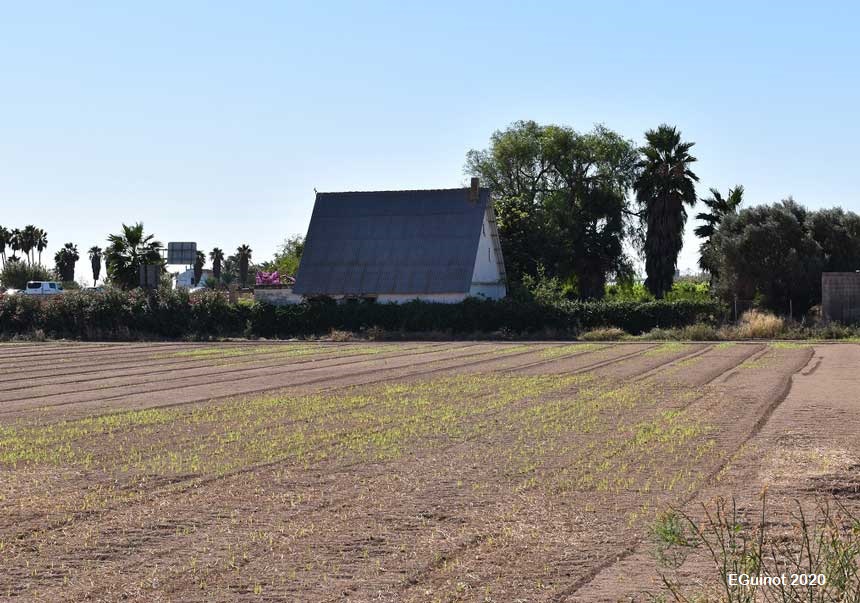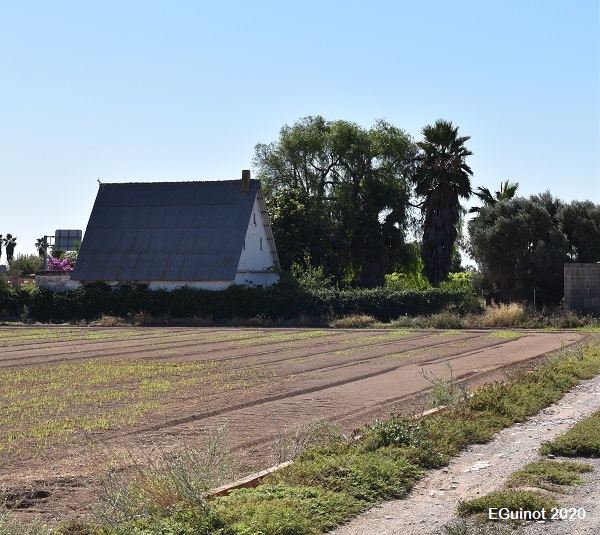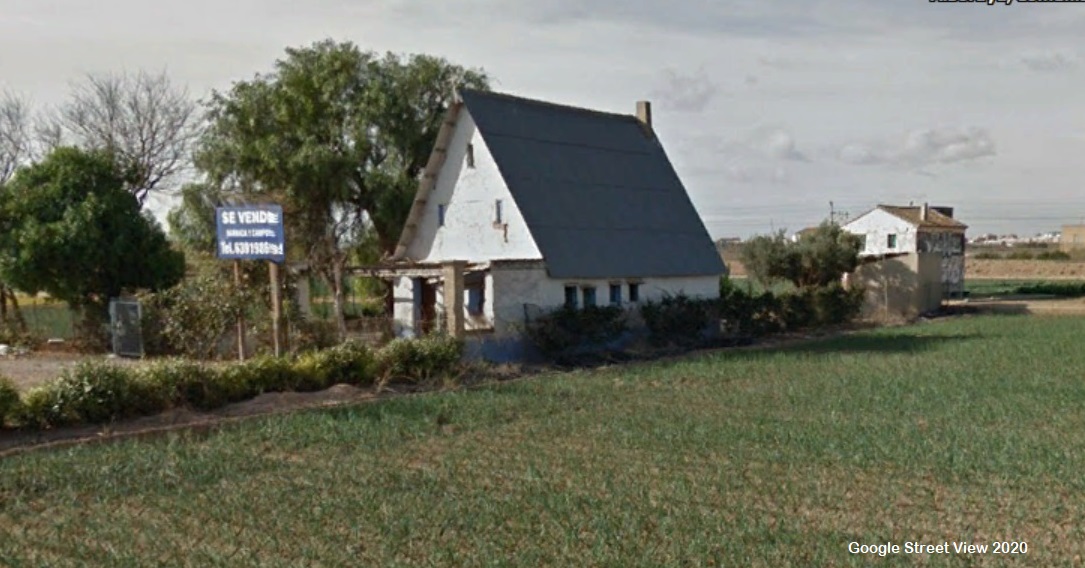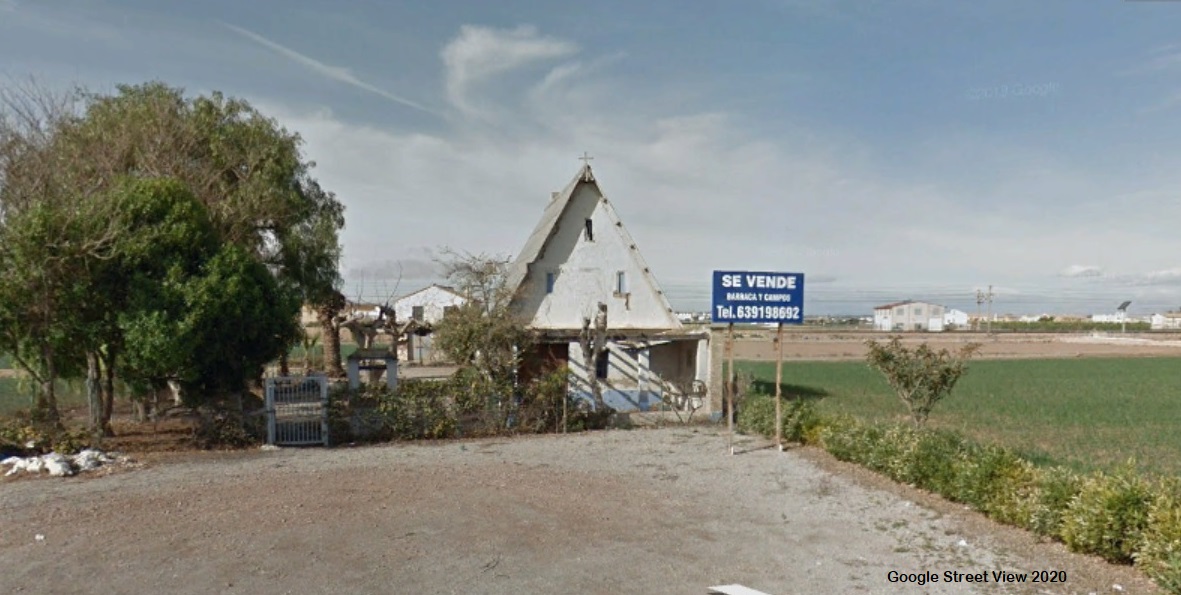
Partida de Sabòia 66. It can be reached via the V-21, exit Port Saplaya and, at the next roundabout towards Almàssera, follow the service road of this dual carriageway towards València and the Carraixet ravine.
In general, it is in good condition, despite being closed.
Late 19th century.
According to M. Del Rey and A. Gallud (PAT of l’Horta, 2018) and the revision of the PGOU of Alboraia (2019), its origins date back to the late 19th or early 20th century, but, as in the case of many of these popular buildings in l’Horta (the irrigated land of València), it is not easy to give a more specific chronology. As in the whole of the periphery of the city of València, many of these barraques (huts) were built during the 19th or early 20th century, even with possible important modifications on the same plot. These barraques do not usually appear in the documentation of the past centuries in an identifiable form by names or place names, while at an oral level they were usually known in their surroundings by the names or place names of the people who owned them or lived there. For this reason, the name of the barraca (hut) was often changed due to the change of residence of these people, and it is difficult to know the specific history of its owners, works, etc. without family or neighbours' testimonies. Its name comes from the ones of the owners during the 20th century. It is currently closed and there is an advertisement for the selling of the barraca and fields.
According to M. Del Rey and A. Gallud (PAT of l’Horta, 2018) and the revision of the PGOU of Alboraia (2019), the alqueria (farmhouse) is still located in a rural, irrigated area of the Alboraia, although it is squeezed between the V-21 motorway, which has been extended to the east, and the València-Barcelona railway line to the west, which affects the overall view of the landscape in which it is integrated. The barraca (hut) is of the “hallway” type, with a door and the interior passageway on the left-hand side and maintains the traditional layout of three small openings on the main façade. The interior layout also seems to be preserved. It is built of adobe, with a plastered and whitewashed exterior. The carpentry of the openings is made of wood and the only relevant change is the current covering of corrugated fibre concrete sheets. It also conserves a terrace in front of the façade with a bower, as well as a kitchen and an exterior chimney and a masonry bench enclosing this space. It has a rectangular floor plan, approximately 7 m (22ft 11.5in) wide at the façade and 11 m (36ft 1in) deep, with a surface area of 77 m2 (828.8 ft2).
(BRL-BRR-PAT HORTA).
According to these authors, this barraca (hut) is a representative example of the most classical model of them at an architectural level. Moreover, it has no adjoining buildings, it has dense trees next to it and it is still surrounded by fields, and it is also completely visible from the two aforementioned access roads to the city of València.
- Plan de Acción Territorial de Protección de la Huerta de Valencia. Versión Preliminar. Memoria de Ordenación. Anexo. Fichas de Elementos Arquitectónicos. Índice de Fichas, (dir. Arancha Muñoz), Generalitat Valenciana, 2008, Element EPA_06.06, p. 251.
- Pla d’Acció Territorial d’Ordenació i Dinamització de l’Horta de València (PAT de l’Horta). Generalitat Valenciana, 2018. Catàleg annex. “Barraca Lladró (de Cucaló)”. Element Patrimonial EPA_06.04, pp. 291-292.
- Proyecto de Revisión del PGOU de Alboraia. Plan General Estructural de Alboraia. Catálogo de Protecciones Estructural. Fichas individualizadas del Catálogo Estructural. 2019.
DEL REY, M. (2010): Arquitectura Rural Valenciana, Barcelona: Galerada (1ª edició: València: Direcció General de Patrimoni Artístic, 1996).
GARCÍA ESPARZA, J. A. (2008): “La barraca valenciana, procesos de transformación”, Revista valenciana d'etnologia, n. 3, pp. 145-159.
CRUZ OROZCO, J. (2003): “Las viviendas de cubierta vegetal en el territorio valenciano: el caso de la barraca”, Revista El Pajar: Cuaderno de Etnografía Canaria, n. 14, pp. 111-116.
SANCHIS GUARNER, M. (1957): Les barraques valencianes, Barcelona, Ed. Barcino (reedició: València, Institució Alfons el Magnànim, 1999).
ALMELA VIVES, F. (1960): La vivienda rural valenciana, Valencia, La Semana Gráfica.
CASAS TORRES, J. M. (1944): La vivienda y los núcleos rurales de la huerta de Valencia, València, Diputació Provincial de València.
RUIZ RUBIO, J. V. (1999): Construint una barraca valenciana, València, Ajuntament d’Alboraia-Col·legi d’Aparelladors i Arquitectes Tècnics de València-Col·legi d’Arquitectes de la Comunitat Valenciana.
GOSÁLVEZ, V.(1915): Estudio constructivo de la Barraca de la Vega Valenciana, Tema de investigación presentado al tribunal de oposiciones. Manuscrito. Biblioteca del COAV. València (Facsimil de: “La Barraca Valenciana”, COACV-Colegio Oficial de Arquitectos de la Comunidad Valenciana, 1998).
Photos: E. Guinot, Google Street View
















